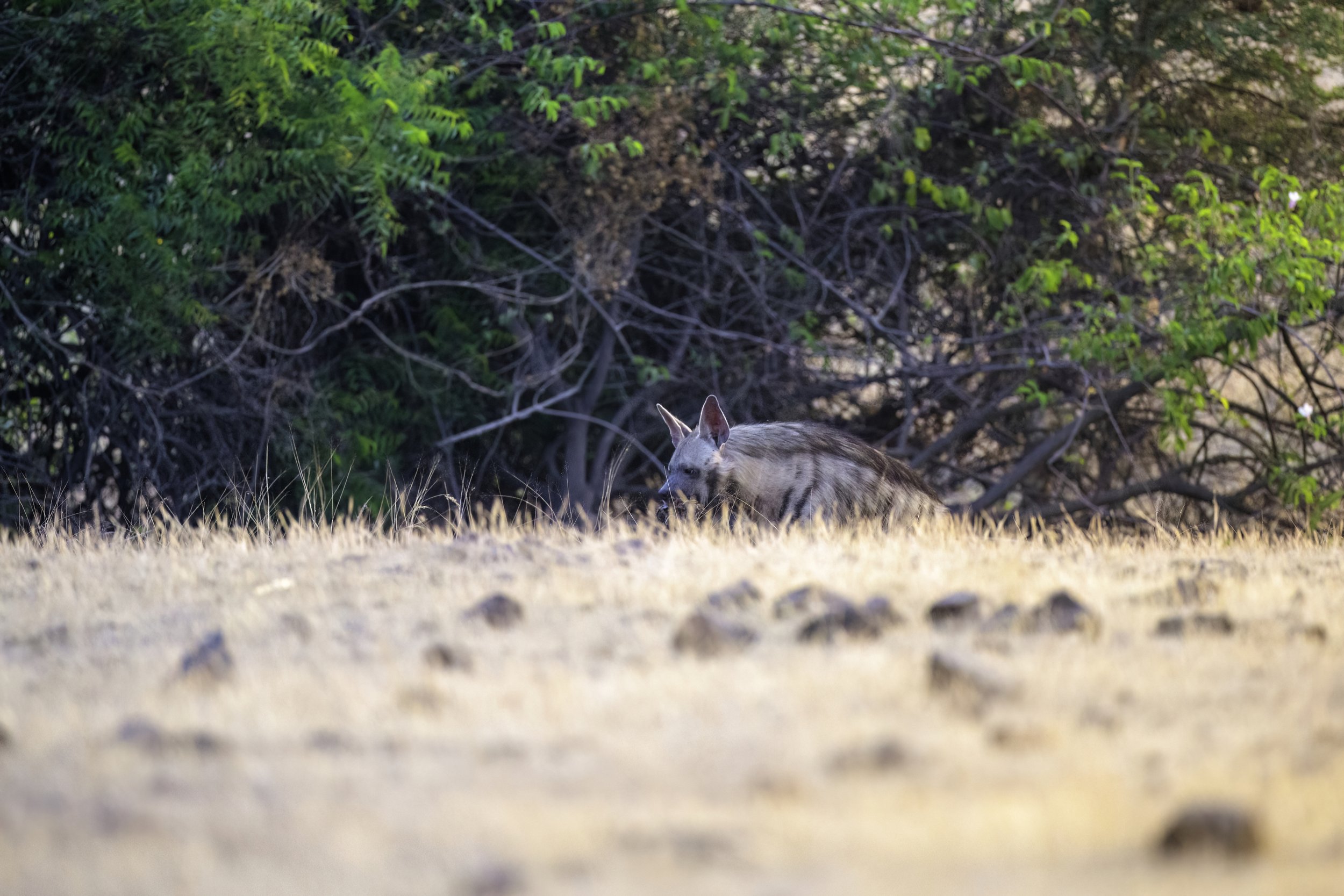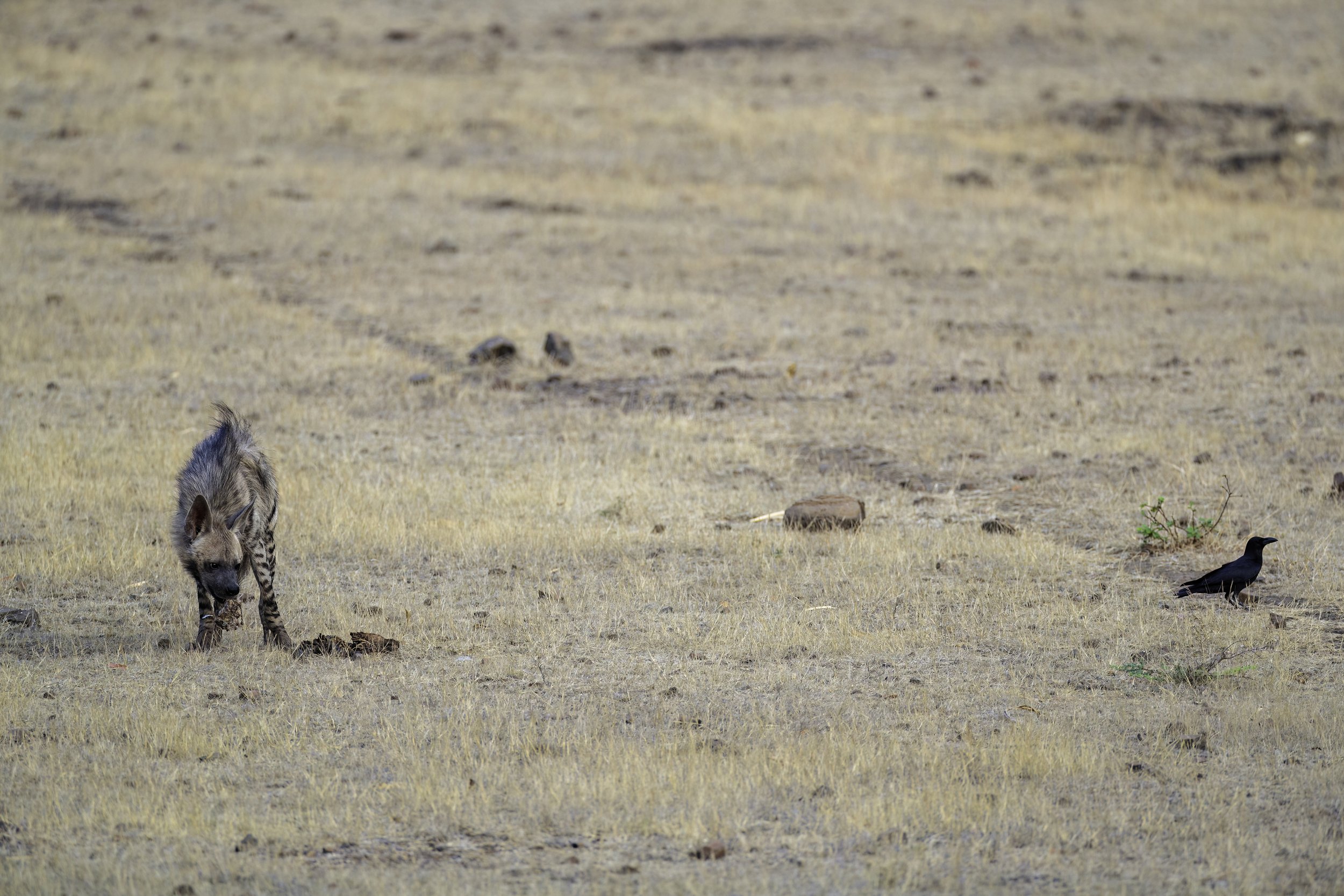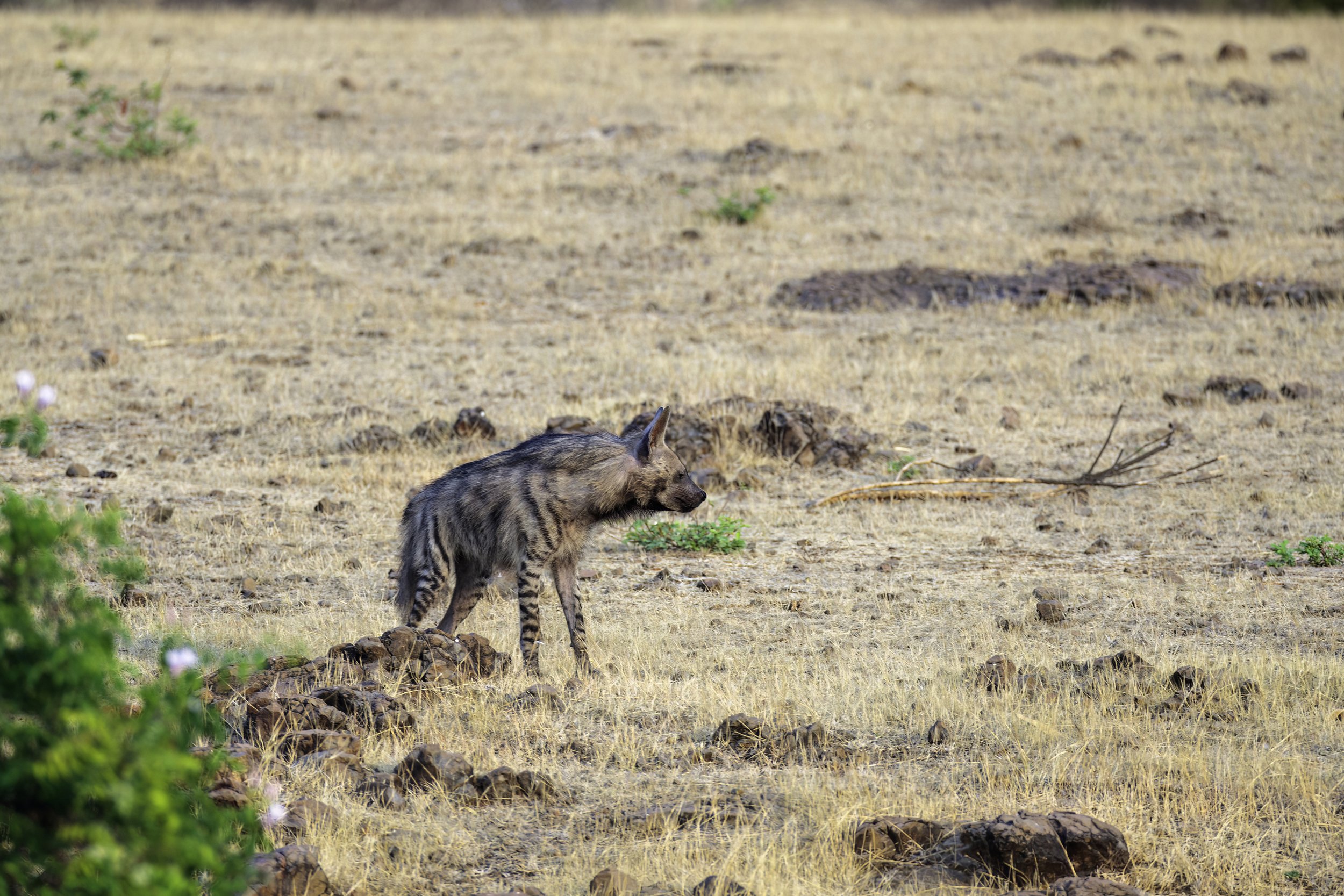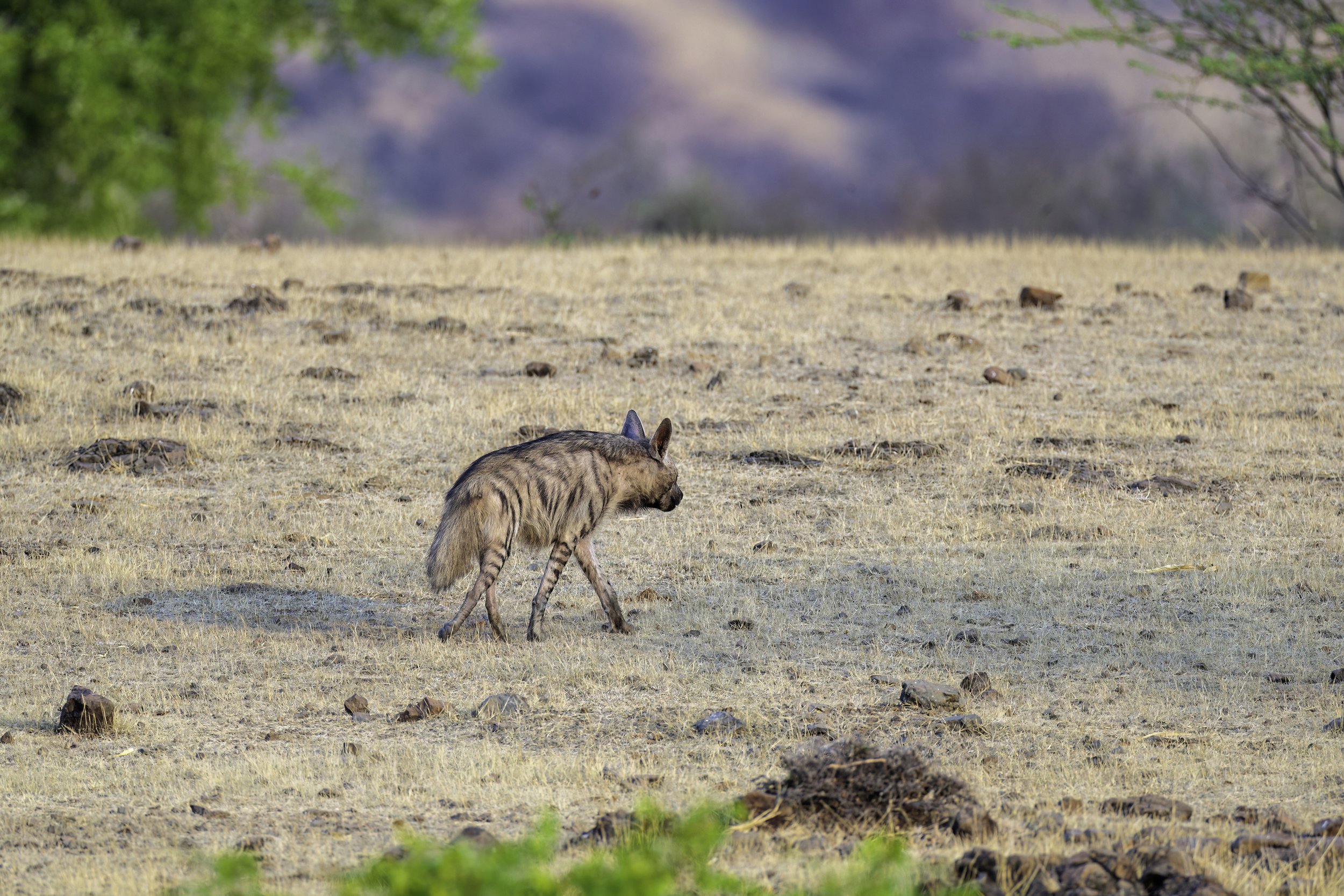Striped Hyena
Hyaena hyaena
NEAR THREATENED
Kadbanwadi Grasslands, Indapur, Maharashtra
Late last month I got a message from my friends at the Agnipankha Flamingo Point saying that they were spotting Hyenas and Wolves regularly at the recently opened Kadbanwadi Grasslands in the Indapur tehsil. These grasslands - there are two, one in Indapur and the other in the Baramati - have a unique ecosystem that attracts a number of birds and animals some of which I have photographed and written about in earlier blogs. I saw the message from Ganesh Bhoi and immediately decided to spend a few days with him and Sandip trying to document the Hyena and the Wolf. The Near Threatened Striped Hyena and the Endangered Indian Grey Wolf have both been bucket list species for me for a long time now. I have tried earlier to photograph them at Rukhad with no success. But this time, given the confidence Ganesh and Sandip exhibited, I was certain of spending some quality time with both species. And what a time it was! Ganesh and I had the entire grasslands to ourselves and spent a lot of quality time with many species. The Hyena however, played hard to get, only showing up after patiently waiting for a few days and the more elusive male that too. But before I get into my experience with the Hyena, a little bit first, about their fast disappearing habitats.
UNESCO defines savannah grasslands as ‘land covered with herbaceous plants with 10 - 40% tree and shrub cover’ (White, 1983). Globally, they cover about 46% of the land surface and contribute to the livelihood of over 800 million people through supporting pastoralism, dairy sector and the agricultural economy (Murray et al., 2000, Sala et al., 2017). Tropical savannah grasslands support the highest diversity of wild herbivores and carnivores globally (Shankaran & Ratnam, 2013). Grasslands are also natural carbon sinks and therefore crucial to the global carbon cycle due to their high rates of productivity, enhanced carbon sequestration rates & geographical extent keeping global temperatures more or less in balance. They are also breeding grounds for many migratory and endangered species like the Indian Grey Wolf of which only about 3,000 are left in the wild. It is a common response from people to think forests when green cover is mentioned but grasslands are of equal import. These open natural ecosystems urgently need attention and government initiatives for protection and conservation.
In India, savannah grassland ecosystems cover various biomes (high-elevation Sholas in the Western Ghats, low-lying peninsulas, Himalayan plateaus, etc.) and occupy 17% of the geographical area of the country (White et al., 2000). In Maharashtra, these ecosystems (patches of >10 km²) take up over 8% of geographical area, including permanent pastures, grazing lands, and fallow land, according to a recent Open Natural Ecosystem (ONE) mapping study (Madhusudan & Vanak, 2021). Indian grasslands come under five categories based on grass species composition and climate (Dabadghao & Shankarnarayan, 1973); these are Sehima - Dichanthium grasslands (Peninsular India and the Aravali range); Dichanthium - Cenchrus - Lasiurus grasslands (Sub-tropical arid and semiarid region); Phragmites - Saccharum - Imperata grasslands (Gangetic plains, Brahmaputra valley, and Punjab); Themeda - Arundinella grasslands (Himalayan foothills); and temperate/alpine grasslands (high altitude Himalaya).
Savannah grasslands in India support at least 46 different nomadic and settled pastoralist communities and greatly subsidise agricultural livelihoods (Kishore & Köhler-Rollefson, 2020). Pastoralism-based economies are the backbone of Indian agriculture, contributing 3% to the national GDP and providing employment and livelihood for 70% of the population in rural areas (Kishore & Köhler-Rollefson, 2020). The number of practising pastoralists is estimated to be close to 13 million in India (Kishore & Köhler-Rollefson, 2020), out of which at least 1-2 million are in Maharashtra. The latter includes communities like Hatkar Dhangar,
Grasslands are not wastelands. It is important to amplify scientific evidence that show ecological value of grasslands and address the identity crisis that is preventing effective interventions. Grassland patches in Maharashtra are found across Marathwada, Vidarbha, Solapur, Satara and other isolated patches along the Western Ghats. According to the Forest Survey of India, permanent pastures, grazing lands, and fallow land account for just 8% of the state’s geographical area. However, there is no estimation or study on how much of this falls within forest areas. Management of grasslands fall under different government departments. An inter-ministerial agency can enable more effective governance.
The Near Threatened Striped Hyena is the only hyena species found in India. It is closely related to two other species of hyenas and the aardwolf. Hyenas in India inhabit a diversity of habitats, from dry open scrub to deciduous forests and agriculture fields. Although they can hunt down prey, hyenas are generally scavengers, feeding on domestic and wild carrion.
The grasslands of Indapur and Baramati are home to a number of species like these hyenas, Indian wolves, jackals, foxes, and a number of migratory & resident birds. Read more about the wildlife of these magnificent and fast disappearing grasslands.
It started with a simple message from Ganesh Bhoi stating the Hyenas are sighted and have cubs. On an earlier visit I had told them that the Hyena and the Grey Wolf were species I wanted to document and here was a fantastic opportunity to do so. It took me a day to sort out my affairs and off I went in search of the elusive Hyena and Grey Wolf. The photos and video featured here are the result of a few days of patient waiting and hoping and many hours spent from dark to dark in more than 41 degrees Celsius.
Striped Hyena
Hyenas or hyaenas are feliform carnivoran mammals belonging to the family Hyaenidae. With just four extant species (each in its own genus), it is the fourth-smallest family in the order Carnivora and one of the smallest in the class Mammalia. Despite their low diversity, hyenas are unique and vital components of most ecosystems.
Although phylogenetically closer to felines and viverrids, hyenas are behaviourally and morphologically similar to canids in several elements due to convergent evolution: both hyenas and canines are non-arboreal, cursorial hunters that catch prey with their teeth rather than claws. Both eat food quickly and may store it, and their calloused feet with large, blunt, nonretractable claws are adapted for running and making sharp turns. However, hyenas' grooming, scent marking, defecation habits, mating and parental behaviour are consistent with the behaviour of other feliforms.
Hyenas feature prominently in the folklore and mythology of human cultures that live alongside them. Hyenas are commonly viewed as frightening and worthy of contempt. In some cultures, hyenas are thought to influence people's spirits, rob graves, and steal livestock and children. Other cultures associate them with witchcraft, using their body parts in traditional medicine. The four extant species are the striped hyena (Hyaena hyaena), the brown hyena (Parahyaena brunnea), the spotted hyena (Crocuta crocuta), and the aardwolf (Proteles cristata).
The Striped Hyena, our interest today, may have evolved from Hyaenictitherium namaquensis of Pliocene Africa. Striped hyena fossils are common in Africa, with records going back as far as the Villafranchian (a period of geologic time spanning the Late Pliocene and Early Pleistocene used more specifically with European Land Mammal Ages. It succeeds the Ruscinian age, and is followed by the Galerian). As fossil striped hyenas are absent from the Mediterranean region, it is likely that the species is a relatively late invader to Eurasia, having likely spread outside Africa only after the extinction of spotted hyenas in Asia at the end of the Ice Age. The striped hyena occurred for some time in Europe during the Pleistocene, having been particularly widespread in France and Germany. It also occurred in Montmaurin, Hollabrunn in Austria, the Furninha Cave in Portugal and the Genista Caves in Gibraltar. The European form was similar in appearance to modern populations, but was larger, being comparable in size to the brown hyena.
The striped hyena (Hyaena hyaena) is native to North and East Africa, the Middle East, the Caucasus, Central Asia, and the Indian subcontinent. It is the only extant species in the genus Hyaena. It is listed by the IUCN as near-threatened, as the global population is estimated to be under 10,000 mature individuals which continues to experience deliberate and incidental persecution along with a decrease in its prey base such that it may come close to meeting a continuing decline of 10% over the next three generations.
It is the smallest of the bone-cracking hyenas and retains many primitive viverrid-like characteristics lost in larger species, having a smaller and less specialised skull. Though primarily a scavenger, large specimens have been known to kill their own prey, and attacks on humans have occurred in rare instances. The striped hyena is a monogamous animal, with both males and females assisting one another in raising their cubs. A nocturnal animal, the striped hyena typically only emerges in complete darkness, and is quick to return to its lair before sunrise. Although it has a habit of feigning death when attacked, it has been known to stand its ground against larger predators in disputes over food.
The striped hyena features prominently in Middle Eastern and Asian folklore. In some areas, its body parts are considered magical, and are used as charms or talismans. It is mentioned in the Hebrew Bible, where it is referred to as tzebua or zevoa, though it is absent in some Bible translations into English. Ancient Greeks knew it as γλάνος (glános) and ύαινα (húaina) and were familiar with it from the Aegean coast of Asia Minor.The striped hyena is the national animal of Lebanon.
The striped hyena has a fairly massive, but short torso set on long legs. The hind legs are significantly shorter than the forelimbs, thus causing the back to slope downwards which leads to a folklore in Rajasthan where the locals refer to it as “daakan ra ghoda – the horse of the witch”. The legs are relatively thin and weak, with the forelegs being bent at the carpal region. The neck is thick, long and largely immobile, while the head is heavy and massive with a shortened facial region. The eyes are small, while the sharply pointed ears are very large, broad and set high on the head. Like all hyenas, the striped hyena has bulky pads on its paws, as well as blunt but powerful claws. The tail is short and the terminal hairs do not descend below the achilles tendon. The female striped hyena's genitalia are transiently masculinised, although it lacks the enlarged clitoris and false scrotal sack noted in the female genitalia of the spotted hyena. The female has 3 pairs of nipples. Adult weight can range from 22 to 55 kg, averaging at about 35 kg. Body length can range from 85 to 130 cm, not counting a tail of 25 to 40 cm, and shoulder height is between 60–80 cm. The male has a large pouch of naked skin located at the anal opening. Large anal glands open into it from above the anus. Several sebaceous glands are present between the openings of the anal glands and above them. The anus can be everted up to a length of 5 cm, and is everted during social interaction and mating. When attacked, the striped hyena everts its rectum and sprays a pungent smelling liquid from its anal glands. Its sense of smell is acute, though its eyesight and sense of hearing are weak which is why we could get close to it without disturbing it too much.
The unglamorous personality of the striped hyena implies that it loses out to the more attractive, ‘flagship’ carnivores like the tiger, lion, and leopard in how it is studied and sighted by researchers and enthusiasts alike in India. The spotted hyena of the African continent, however, is better known outside of research circles than its striped cousin due to the efforts of filmmakers like Beverly and Dereck Joubert. Also, the spotted hyena is less nocturnal, less solitary, and less reticent than the striped hyena, which has also contributed to the latter’s lesser-known status here. And of course, its reputation doesn’t help its completely undeserved image. The hyena is neither evil or cunning, nor a solitary scavenger. What this intelligent mammal desperately needs is an image makeover.
The hyena, in most of its range, is the largest carnivore and faces little competition from leopards and tigers. And since there isn’t any other species trying to attack them, they are able to spend more time in cub rearing resulting in low mortality. This is the situation prevalent in these grasslands as well since the only other predator of note here is the Endangered Indian Wolf. In cub rearing, the hyenas form a family-based unit that may consist of a mother, and her litter and the dens here were a complex of multiple simple dens implying that an otherwise solitary animal has adapted to live socially like we do in our societies and colonies. But that said at this location there is also a wild boar den in the near vicinity - about 500 meters away at most. The presence of this wild boar den has most certainly impacted the behaviour of the hyenas and may have pushed them to seek shelter further away.
The Striped Hyena has a very large, albeit now patchy distribution, extending from Africa, north of and including the Sahel, and including much of east and northeast Africa south to about central Tanzania, through the Middle East and Arabian Peninsula, Turkey, the Caucasus, Central Asia, and the Indian subcontinent, though not reaching Assam, Bhutan or Myanmar. They may have recently expanded into Nepal (Hofer and Mills 1998a).
Although historically present, there are few reliable recent records of occurrence in Sudan, Eritrea, Somalia, Qatar, Kuwait, and the United Arab Emirates (Andrews 2008, Cunningham 2004, Hofer and Mills 1998a). However, recent records for Syria (Palmyra area and other Syrian governorates; Masseti 2009, A. Shehab pers. comm. 2014, G. Serra pers. comm. 2014) and Pakistan (Balochistan province, Ghalib et al. 2007) confirmed its occurrence. Kasparek et al. (2004) discuss the recent distribution of the species in Turkey. In Lebanon (Abi-Said and Marrouche Abi-Said 2007) and Jordan (Qarqaz et al. 2004) Striped Hyenas remain widely distributed across both countries.
A citizen science initiative called Wild Canids–India Project is documenting hyenas and other canids across the country while sharing relevant information about identifying them and understanding their world. Their objective is aimed at making ecological and conservation assessments of wild canids in India. The project focuses on eight species & sub-species of wild canids: dhole, golden jackal, Indian wolf, Tibetan wolf, Indian fox, red fox, desert fox and Tibetan fox. They have also included the striped hyena in the project because of its similarities with wild canids in aspects like natural history, ecological requirements and conservation issues. If you are interested in contributing to this project or learning more about the hyenas and other canids, share details of your sightings with the project and read more about their conservation scorecards to gain a comprehensive overview of the species.
Follow them on their website and Instagram.
‡‡‡‡‡
Related Posts




















